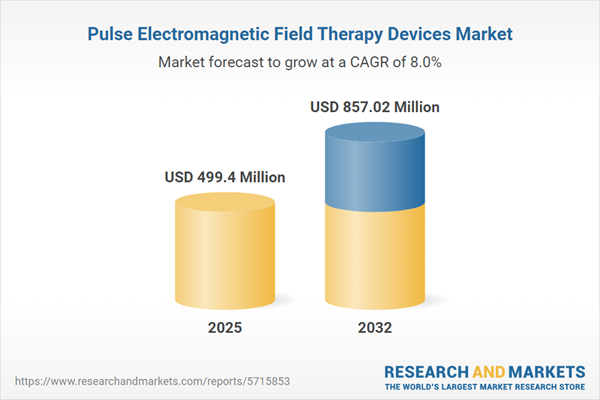Speak directly to the analyst to clarify any post sales queries you may have.
The pulse electromagnetic field therapy devices market is progressing steadily as healthcare leaders seek effective, adaptable treatment solutions that align with advances in patient care and operational demands. Progressive organizations recognize the potential of these devices to expand care settings and optimize clinical outcomes.
Pulse Electromagnetic Field Therapy Devices Market Snapshot
Between 2024 and 2032, the pulse electromagnetic field therapy devices market is projected to increase from USD 462.61 million to USD 857.02 million, demonstrating an 8.01% compound annual growth rate (CAGR). This sustained growth is attributed to the widespread adoption of electromagnetic therapy across healthcare facilities and residences. Regular product enhancements, coupled with mounting clinical validation and positive reception among healthcare professionals, are driving device acceptance. For senior decision-makers, understanding evolving compliance frameworks and shifts in care delivery models is essential for market strategy and competitive positioning.
Scope & Segmentation in the Pulse Electromagnetic Field Therapy Devices Market
This report delivers an in-depth analysis to inform strategic moves across the entire pulse electromagnetic field therapy devices market. Segment-specific insights allow executives to target resources and refine offerings to suit diverse user needs and regional nuances.
- Product Types: Portable wearable devices, handheld units, and stationary systems are designed to address requirements across hospitals, outpatient clinics, and home-based care environments.
- Applications: Use cases include pain management, injury recovery, bone and fracture healing, assisted rehabilitation, stress reduction, improvements in sleep quality, and meeting personal wellness objectives.
- End Users: Hospitals, home health providers, sports organizations, outpatient clinics, research and academic institutions, and individual consumers represent key user groups, each with distinct operational and care delivery prerequisites.
- Distribution Channels: Direct sales, hospital pharmacies, e-commerce options, manufacturer networks, specialized healthcare suppliers, and third-party distributors support flexible and scalable procurement across regions.
- Technologies: Devices utilize both low-frequency and high-frequency electromagnetic field formats, matched to tailored therapeutic needs across preventative and rehabilitative care models.
- Regions: The market overview spans the Americas, Europe, Middle East, Africa, and Asia-Pacific, highlighting differentiated adoption rates, compliance scenarios, and growth prospects shaped by local health systems and regulatory environments.
Key Takeaways for Senior Decision-Makers
- Mobile and wearable electromagnetic field therapy devices enable care delivery beyond traditional settings, improving care access for patients in home and community locations.
- Advancements in nonpharmaceutical interventions are reshaping clinical protocols in musculoskeletal and chronic pain management, supporting integration into multidisciplinary care models and rehabilitation.
- Product innovations and collaborations between device manufacturers, providers, and sports medicine experts are enhancing therapy acceptance and amplifying patient engagement and access.
- Strategic updates to supply chain management and procurement approaches address resource costs and regulatory compliance shifts, ensuring operational resilience despite market uncertainty.
- Clearer regulatory guidelines and more streamlined reimbursement processes accelerate the path to clinical integration for new therapy devices, supporting timely adoption and patient benefit.
- Expanding capabilities in device connectivity and real-time data tracking support individualized treatment planning, drive outcome monitoring, and enhance provider decision-making through actionable analytics.
Tariff Impact on Pulse Electromagnetic Field Therapy Devices
Recent tariffs imposed on key U.S. components have elevated production costs for manufacturers. To address these pressures and reduce supply chain vulnerabilities, many organizations are relocating operations closer to primary markets and forming alliances with regional suppliers. These adaptive measures bolster distribution reliability, particularly during periods of market flux or unpredictability.
Methodology & Data Sources
This analysis integrates insights from industry interviews with device producers, healthcare practitioners, and procurement specialists. All conclusions are validated against reviewed regulatory submissions, peer-reviewed clinical studies, and authenticated industry statistics, ensuring findings are grounded in current, relevant data for senior stakeholders.
Why This Report Matters
- Equips senior executives with actionable insight on technology adoption, supporting timely decisions for device integration and care innovation.
- Addresses sourcing and compliance complexities to help leaders navigate emerging challenges, adapt to regulatory demands, and safeguard organizational continuity.
- Presents benchmarking tools and planning resources for informed market entry, expansion, and scenario analysis within shifting compliance environments.
Conclusion
Investing in pulse electromagnetic field therapy device solutions positions organizations for enhanced care delivery and adaptability as the healthcare sector evolves through ongoing clinical and regulatory transformations.
Additional Product Information:
- Purchase of this report includes 1 year online access with quarterly updates.
- This report can be updated on request. Please contact our Customer Experience team using the Ask a Question widget on our website.
Table of Contents
3. Executive Summary
4. Market Overview
7. Cumulative Impact of Artificial Intelligence 2025
Companies Mentioned
The companies profiled in this Pulse Electromagnetic Field Therapy Devices market report include:- Orthofix Medical Inc.
- Bioventus LLC
- IGEA S.p.A
- Swiss Bionic Solutions AG
- BEMER International AG
- Curatron AG
- Mettler Electronics AB
- Medithera GmbH
- MagnaWave LLC
- Quantum Resonance Systems LLC
Table Information
| Report Attribute | Details |
|---|---|
| No. of Pages | 195 |
| Published | October 2025 |
| Forecast Period | 2025 - 2032 |
| Estimated Market Value ( USD | $ 499.4 Million |
| Forecasted Market Value ( USD | $ 857.02 Million |
| Compound Annual Growth Rate | 8.0% |
| Regions Covered | Global |
| No. of Companies Mentioned | 11 |









